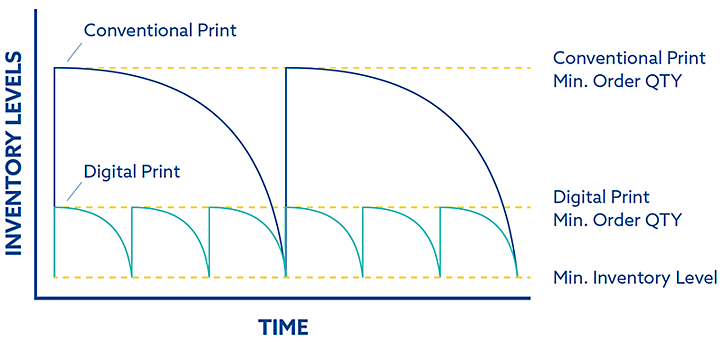Just a few weeks ago it’s unlikely any of us would have grasped just how much of our lives would be ruled by the concepts of self-distancing, self-quarantine, masks, 2 m between shoppers, alcogel hand sanitizer, toilet paper 😊… and the list goes on.
When talking about the effects of Covid-19 on packaging the first question that came to mind was “how long can the virus last on a corrugated box?”, followed rapidly by “am I still going to be receiving orders from China?” and then a whole barrage of new trends that generate new questions and a radically new way of looking at things.
Local production
With the understandable reluctance to order manufacture from China, combined with the almost total reduction of flight and land transport, the ability to produce locally has become important in order to keep up with the incessant fluctuations of demand. This drives a real need for both product and packaging manufacture locally. Manufacturing competition from China has, at least for the moment, become irrelevant.
In-house production
Reduced dependence on outsourcing – some Highcon customers have seen an uptick in the volume of work they have received due to their ability to produce packaging in-house without the dependence on outsourced die-making and transport of the dies to the premises.
On-demand production, not delivery.
An article by McKinsey on Covid-19 – Implications for business, says quite clearly: “Perhaps the biggest uncertainty for supply-chain managers and production heads is customer demand. Customers that have pre-booked logistics capacity may not use it; customers may compete for prioritization in receiving a factory’s output; and the unpredictability of the timing and extent of demand rebound will mean confusing signals for several weeks.” No-one has any idea about inventory requirements – and so the ability to manufacture on-demand becomes priceless. This may turn out to be the single most important effect when we finally come out the other side of the virus, adding positive cash flow from shorter packaging runs. This is clearly explained by The Boxmaker, the Pacific Northwest leader in packaging innovation, in their blog: “a shorter replenishment cycle means that buyers can order smaller volumes of packaging at a more constant rate, with the opportunity to adjust the quantity and frequency based on current sales data rather than long-term projections which may prove to be inaccurate.”
This buying approach creates a more agile supply chain by reducing lead times, increasing speed-to-market, and cutting down on warehousing costs.
BX Conventional vs Digital Print Supply Chain
Cost increases.
According to The Guardian UK faces cardboard shortage due to the Corona crisis. “Fibre recycling is a global market and materials flow across Europe and the world, but the lockdown means physical barriers are increasingly springing up to prevent this distribution. In Germany – the biggest European player – significant volumes of fibre come from Poland, but the Poland-Germany border is now shut. This has meant Germany is now seeking material from France and the UK.” In this area, the Highcon digital process has a distinct advantage. The digital, non-impact process maintains board integrity, meaning that converters can produce boxes of the same strength using thinner, less expensive board. This not only makes lightweighting and rightsizing simple but also offers a way to maintain profit margins.
Employee recruitment, retention and training
With converters, like all companies, having to limit entry to the plant to employees and supplier personnel, as well as the need to comply with “social distancing” requirements in a factory environment, the more modern “digital” employees are far more flexible. They can be deployed at different machines without too much effort, and without the need for special skills. Training can also be carried out remotely on digital machinery for new hires or temporary labor. In addition, once restrictions begin to be lifted, operating digital packaging equipment may be attractive to many who have been unemployed during the crisis and especially the young generation.
Online ordering
Across the globe in every country online ordering has become the norm as people are effectively housebound. On the one hand this produces a greater demand for packaging. On the other, for packaging manufacturers, with a reduced number of employees, the need for an online sales process becomes quite essential.
Supply Chain Changes
“With the supply chain industry facing several challenges, including shifting customer demand, restrictions and potential material shortages, the outbreak has forced many to rapidly adapt their supply chains” ( Supply Chain: COVID-19: Five priorities for retail supply chain) . The combination of unpredictable inventory together with transport limitations has encouraged producers to use ever more flexible distribution methods. Some cut out specific stages bypassing distribution centers and shipping goods directly to stores. Staff are being cross-trained and many of the newly unemployed are being hired to support deliveries or fulfilment roles.
None of us knows how things will look when we come out of the numerous restrictions of the current period. One thing though, is quite clear. As Robert C. Wolcott wrote, in Forbes, “COVID19 makes resistance to digital transformation appear short-sighted, even naive. Digital savvy companies are more effectively shifting to remote work, re-organizing stressed supply chains, supporting customers and partners in crisis mode.”
Digital technology is no longer nice-to-have but must-have throughout the supply chain.

